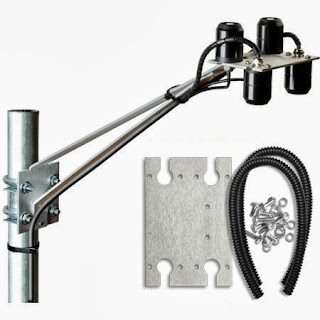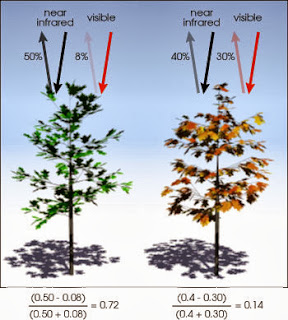Remote sensing uses images from satellite or hovercrafts using visible IR NIR and multispectral cameras, these methods are costly and involves a lot of mathematical calculation to retrieve the useful information from the images. Well, the most useful parameter for agriculture is the NDVI.
Normalized Difference Vegetative Index (NDVI) is a ratio of reflectance of two spectrums, RED/Visible and NIR.
NDVI bracket uses two pairs of Sensors One pair for measuring the incoming solar radiance in both the spectras and the second pair two monitor the reflected light intensity from the crops in both spectras.
Active NDVI Sensor
Normalized Difference Vegetative Index (NDVI) is a ratio of reflectance of two spectrums, RED/Visible and NIR.
 |
| NIR=NIR reflectance, VIS=Reflectance in Visible spectra |
0r
 |
| NIR=NIR reflectance, VIS=Reflectance in Red |
Why NDVI is useful ?
\Healthy plants with enough nitrogen i.e. enough cholrophyll do photosynthesis when they are exposed to visible or PAR, so they absorb the radiation, where as the spectra above 700 nm is not absorbed nor transmitted by Healthy leaves, so there is a steep increase in reflectance above this frequency, although there are other factors which may affect reflectivity of IR but these factors dominate all others.
But in all healthy plants these change does not happen reflection is relatively same or color specific, so this can be used to detect healthy crops.
 |
| Plant Reflection Spectra |
Portable NDVI Sensor
Although this parameter was developed by remote sensing experts for their use, it is now used in handheld sensors too. These are categorised in two groups
- Active NDVI Sensor
- Passive NDVI Sensor
Passive NDVI Sensors
Well these passive sensors are similar to radiometric spectral survey, instead using single spectra as in radiometric survey they use two bands which have centers at the priority spectrums i.e. Red and NIR. The most popular sensor of this type is the NDVI bracket using two sensors 1. PAR sensor, 2.Pyrometric IR sensor.
 |
| NDVI Bracket marketed by HOBO Dataloggers |
Active NDVI Sensor
These sensors does not use solar radiance for measurement instead they use their own light sources, Some of them use polychromatic light source (Holland scientific) and some use monochromatic light source. They use a pulse modulated light to reduce effect of drift due to change in solar irradiance.
GreenSeeker Ntech(Acquired By Trimble Navigations)
They use two set of LEDs for Red(660nm) and NIR (750nm now shifted to 770nm)which are pulsed one by one and measure the reflectivity displayed in a numeric display(in new portable sensor) or acquired by a attached datalogger, they have also CAN supported sensors for use in automated variable rate fertiliser spray)
from the above picture one can guess How a multispectral camera can be used to extract lot of information for plant phenotyping.
 |
| Portable NDVI Sensor |
 |
| NDVI Sensor |
NDVI sensor CM-1000 from Spectrum technologies
Plant Pen/NDVI Pen from Qubit systems
Crop sensor from Holland scientific
Holland scientific uses relatively differnt technique than the others, it is similar to differnce between dispersive spectrometer and Non-disperssive spectrometry. All others use the active light source with monochromatic output, where as holland scientific uses polychromatic source, which is more similar to solar irradiance simulating a normal experimental condition.(assuming monochromatic source may change normal photosynthetic response)
RapidScan CS 45
Crop circle ACS-470
Agleader OPTRX
OptRx uses a red-edge light wave to scan plants. Most competitive products use only a red wavelength, which has been shown in studies to be non-responsive at high plant density. The red-edge lightwave stays responsive to health-stress on plants at later growth stages than other competitive products.
OptRx crop sensors use a single algorithm application. Trials have been conducted in multiple states that have shown positive results of using a single algorithm in comparison to multiple algorithms.
Other Useful Spectras:
 |
| PIC from cirrus digital systems |
Except this there are some other optical methods like fluorescence as the chlorophylls exhibit a fluorescence effect, absorbing in 440 nm(blue) and emitting back in 600-650nm(red), which is known as chlorophyll fluorescence or plant fluorescence. for analysis of phtosynthesis process this is most useful, Kautsky effect can be observed with this method.
For phenotyping inside lab fluorescence imaging is the best and accurate, other cheaper alternatinve is fluorescence Sensor like FMS
NB: am an instrument engineer, all those reviews and declarations is based on my knowledge as a engineer and physicist , am not a biologist or plant physiologist, if you have any suggestion please send me mail or add a comment below in the comment section thank you.
Ref






